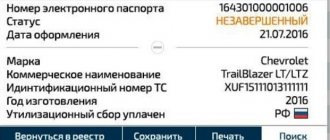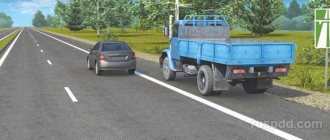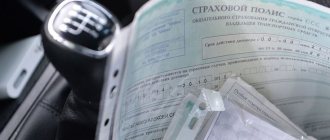How much does OSAGO cost in 2018?
So, first we will explain how the calculation of the insurance premium (the one that is paid when purchasing a policy) works in accordance with the rules of OSAGO.
- There is a base rate in the form of a price range that the insurance companies themselves have the right to set (but more often maximum values are set),
- And there are coefficients that depend on the data of the drivers allowed to drive and the parameters of the car and which are applied in turn to the base tariff by multiplying the latter by these coefficients.
The increase in the cost of compulsory motor liability insurance this time is due to an increase in the base tariff (in fact, the corridor is simply increasing), as well as several coefficients applied to the base tariff.
The final price of the policy is calculated using the following formulas:
- for passenger cars of individuals : basic tariff x territorial coefficient (region of registration of the owner) x bonus-malus coefficient (accident-free driving) x limited/unlimited insurance x vehicle power x seasonality of use x number of violations in the previous insurance period;
- for passenger cars of legal entities : basic tariff x territorial coefficient (region of registration of the owner) x bonus-malus coefficient (accident-free driving) x age/experience of approved drivers x limited/unlimited insurance x vehicle power x seasonality of use x number of violations in the previous insurance period x availability of a trailer;
- for motorcycles and trucks of individuals : basic tariff x territorial coefficient (region of registration of the owner) x bonus-malus coefficient (accident-free driving) x age/experience of approved drivers x limited/unlimited insurance x seasonality of use x number of violations in the previous insurance period x availability trailer;
- for motorcycles and trucks of individuals : basic tariff x territorial coefficient (region of registration of the owner) x bonus-malus coefficient (accident-free driving) x limited/unlimited insurance x seasonality of use x number of violations in the previous insurance period x availability of a trailer.
A small addition has appeared in the MTPL calculation forums - this is the coefficient of the number of violations. Previously, it was not applied, but at the new rates it will be applied and will always be equal to 1.5 if there were violations of the insurance rules in the previous period:
- if the driver knowingly provided false information when applying for insurance, which affected the reduction in the cost of the policy,
- if the driver deliberately staged an accident or lied about damage information,
- if the driver has been presented with a recourse claim.
So, now let's move directly to the numbers, and in the “was/has become” format we will present all the changes in insurance rates and coefficients!
You will also be interested in:
- OSAGO 2021 – what’s new and what changes?
- How much more expensive will OSAGO insurance be after an accident?
- What changes are being made to compulsory motor liability insurance from April 1, 2021? Will insurance become more expensive?
Maximum insurance cost
Another important innovation, which is not immediately noticeable in the text of the regulatory document, is the abolition of the restriction on the maximum cost of compulsory motor insurance:
5. The maximum amount of the insurance premium under a compulsory insurance contract cannot exceed 3 times the base rate of the insurance tariff, adjusted depending on the territory of primary use of the vehicle, and when applying the KN coefficient provided for in paragraph 9 of Appendix 2 to this Directive, its 5 times size.
This means that if the driver “collects” several increasing factors, then each of them will be taken into account in full.
For example, previously the maximum cost of OSAGO for category B in Moscow (limited to 5 times the amount) was 41,180 rubles.
Taking into account the abolition of the upper limit, the maximum cost of a category B policy in Moscow is 108,681 rubles.
Increasing the basic MTPL tariff
Here, as we already mentioned above, in 2021 it was not the tariff itself that increased, but the range of possible prices applied by insurers for these tariffs.
| Transport category | Was | It became |
| Motorcycles and scooters (A and M) | 867-1579 | 694-1407 |
| Passenger cars (B and BE) of individuals | 3432-4118 | 2746-4942 |
| Passenger cars (B and BE) of legal entities | 2573-3087 | 2058-2911 |
| Passenger cars (B and BE) taxis | 5138-6166 | 4110-7399 |
| Trucks (C and CE) with a permissible weight of 16 tons | 3509-4211 | 2807-5053 |
| Trucks (C and CE) with a permissible weight of more than 16 tons | 5284-6341 | 4227-7609 |
As you can see, in the basic tariffs, the increase in compulsory motor liability insurance affected only the most popular categories of vehicles: passenger cars. persons, taxi drivers and trucks.
Formula for self-calculation of compulsory motor liability insurance
To calculate your MTPL policy yourself, you need to strictly follow the established formula and procedure for using the coefficients. It looks like this:
Cost of OSAGO=BT×KBM×KVS×KN×KT×KO×KM×KSS
In this formula, BT is the base tariff, which is selected from the range established by the Central Bank of the Russian Federation for each category of vehicles. The indicator is also affected by the tonnage of trucks and the number of passenger seats in cars and buses. Let's look at the features of the current base rate and odds.
Region of residence coefficient
It is correctly called the “territorial coefficient”. And this coefficient was not affected by the increase.
Show odds table
| Region of transport use | Coefficient |
| Republic of Adygea | 1,3 |
| Altai Republic | |
| Gorno-Altaisk | 1,3 |
| Other cities and towns | 0,7 |
| Republic of Bashkortostan | |
| Blagoveshchensk, Oktyabrsky | 1,2 |
| Ishimbay, Kumertau, Salavat | 1,1 |
| Sterlitamak, Tuymazy | 1,3 |
| Ufa | 1,8 |
| Other cities and towns | 1 |
| The Republic of Buryatia | |
| Ulan-Ude | 1,3 |
| Other cities and towns | 0,6 |
| The Republic of Dagestan | |
| Buynaksk, Derbent, Kaspiysk, Makhachkala, Khasavyurt | 0,7 |
| Other cities and towns | 0,6 |
| The Republic of Ingushetia | |
| Malgobek | 0,8 |
| Nazran | 0,6 |
| Other cities and towns | 0,6 |
| Kabardino-Balkarian Republic | |
| Nalchik, Prokhladny | 1 |
| Other cities and towns | 0,7 |
| Republic of Kalmykia | |
| Elista | 1,3 |
| Other cities and towns | 0,6 |
| Karachay-Cherkess Republic | 1 |
| Republic of Karelia | |
| Petrozavodsk | 1,3 |
| Other cities and towns | 0,8 |
| Komi Republic | |
| Syktyvkar | 1,6 |
| Ukhta | 1,3 |
| Other cities and towns | 1 |
| Republic of Crimea | |
| Simferopol | 0,6 |
| Other cities and towns | 0,6 |
| Mari El Republic | |
| Volzhsk | 1 |
| Yoshkar-Ola | 1,4 |
| Other cities and towns | 0,7 |
| The Republic of Mordovia | |
| Ruzaevka | 1,2 |
| Saransk | 1,5 |
| Other cities and towns | 0,8 |
| The Republic of Sakha (Yakutia) | |
| Neryungri | 0,8 |
| Yakutsk | 1,2 |
| Other cities and towns | 0,6 |
| Republic of North Ossetia-Alania | |
| Vladikavkaz | 1 |
| Other cities and towns | 0,8 |
| Republic of Tatarstan | |
| Almetyevsk, Zelenodolsk, Nizhnekamsk | 1,3 |
| Bugulma, Leninogorsk, Chistopol | 1 |
| Elabuga | 1,2 |
| Kazan | 2 |
| Naberezhnye Chelny | 1,7 |
| Other cities and towns | 1,1 |
| Tyva Republic | |
| Kyzyl | 0,6 |
| Other cities and towns | 0,6 |
| Udmurt republic | |
| Votkinsk | 1,1 |
| Glazov, Sarapul | 1 |
| Izhevsk | 1,6 |
| Other cities and towns | 0,8 |
| The Republic of Khakassia | |
| Abakan, Sayanogorsk, Chernogorsk | 1 |
| Other cities and towns | 0,6 |
| Chechen Republic | 0,6 |
| Chuvash Republic | |
| Kanash | 1,1 |
| Novocheboksarsk | 1,2 |
| Cheboksary | 1,7 |
| Other cities and towns | 0,8 |
| Altai region | |
| Barnaul | 1,7 |
| Biysk | 1,2 |
| Zarinsk, Novoaltaisk, Rubtsovsk | 1,1 |
| Other cities and towns | 0,7 |
| Transbaikal region | |
| Krasnokamensk | 0,6 |
| Chita | 0,7 |
| Other cities and towns | 0,6 |
| Kamchatka Krai | |
| Petropavlovsk-Kamchatsky | 1,3 |
| Other cities and towns | 1 |
| Krasnodar region | |
| Anapa, Gelendzhik | 1,3 |
| Armavir, Sochi, Tuapse | 1,2 |
| Belorechensk, Yeisk, Kropotkin, Krymsk, Kurganinsk, Labinsk, Slavyansk-on-Kubani, Timashevsk, Tikhoretsk | 1,1 |
| Krasnodar, Novorossiysk | 1,8 |
| Other cities and towns | 1 |
| Krasnoyarsk region | |
| Achinsk, Zelenogorsk | 1,1 |
| Zheleznogorsk, Norilsk | 1,3 |
| Kansk, Lesosibirsk, Minusinsk, Nazarovo | 1 |
| Krasnoyarsk | 1,8 |
| Other cities and towns | 0,9 |
| Perm region | |
| Berezniki, Krasnokamsk | 1,3 |
| Lysva, Tchaikovsky | 1 |
| Permian | 2 |
| Solikamsk | 1,2 |
| Other cities and towns | 1,1 |
| Primorsky Krai | |
| Arsenyev, Artem, Nakhodka, SpasskDalniy, Ussuriysk | 1 |
| Vladivostok | 1,4 |
| Other cities and towns | 0,7 |
| Stavropol region | |
| Budennovsk, Georgievsk, Essentuki, Mineralnye Vody, Nevinnomyssk, Pyatigorsk | 1 |
| Kislovodsk, Mikhailovsk, Stavropol | 1,2 |
| Other cities and towns | 0,7 |
| Khabarovsk region | |
| Amursk | 1 |
| Komsomolsk-on-Amur | 1,3 |
| Khabarovsk | 1,7 |
| Other cities and towns | 0,8 |
| Amur region | |
| Belogorsk, Svobodny | 1,1 |
| Blagoveshchensk | 1,6 |
| Other cities and towns | 1 |
| Arhangelsk region | |
| Arkhangelsk | 1,8 |
| Kotlas | 1,6 |
| Severodvinsk | 1,7 |
| Other cities and towns | 0,85 |
| Astrakhan region | |
| Astrakhan | 1,4 |
| Other cities and towns | 0,8 |
| Belgorod region | |
| Belgorod | 1,3 |
| Gubkin, Stary Oskol | 1 |
| Other cities and towns | 0,8 |
| Bryansk region | |
| Bryansk | 1,5 |
| Klintsy | 1 |
| Other cities and towns | 0,7 |
| Vladimir region | |
| Vladimir | 1,6 |
| Gus-Khrustalny | 1,1 |
| Moore | 1,2 |
| Other cities and towns | 1 |
| Volgograd region | |
| Volgograd | 1,3 |
| Volzhsky | 1,1 |
| Kamyshin, Mikhailovka | 1 |
| Other cities and towns | 0,7 |
| Vologda Region | |
| Vologda | 1,7 |
| Cherepovets | 1,8 |
| Other cities and towns | 0,9 |
| Voronezh region | |
| Borisoglebsk, Liski, Rossosh | 1,1 |
| Voronezh | 1,5 |
| Other cities and towns | 0,8 |
| Ivanovo region | |
| Ivanovo | 1,8 |
| Kineshma | 1,1 |
| Shuya | 1 |
| Other cities and towns | 0,9 |
| Irkutsk region | |
| Angarsk | 1,2 |
| Bratsk, Tulun, Ust-Ilimsk, Ust-Kut, Cheremkhovo | 1 |
| Irkutsk | 1,7 |
| Usolye-Sibirskoye | 1,1 |
| Shelekhov | 1,3 |
| Other cities and towns | 0,8 |
| Kaliningrad region | |
| Kaliningrad | 1,1 |
| Other cities and towns | 0,8 |
| Kaluga region | |
| Kaluga | 1,2 |
| Obninsk | 1,3 |
| Other cities and towns | 0,9 |
| Kemerovo region | |
| Anzhero-Sudzhensk, Kiselevsk, Yurga | 1,2 |
| Belovo, Berezovsky, Mezhdurechensk, Osinniki, Prokopyevsk | 1,3 |
| Kemerovo | 1,9 |
| Novokuznetsk | 1,8 |
| Other cities and towns | 1,1 |
| Kirov region | |
| Kirov | 1,4 |
| Kirovo-Chepetsk | 1,2 |
| Other cities and towns | 0,8 |
| Kostroma region | |
| Kostroma | 1,3 |
| Other cities and towns | 0,7 |
| Kurgan region | |
| Mound | 1,4 |
| Shadrinsk | 1,1 |
| Other cities and towns | 0,6 |
| Kursk region | |
| Zheleznogorsk | 1 |
| Kursk | 1,2 |
| Other cities and towns | 0,7 |
| Leningrad region | 1,3 |
| Lipetsk region | |
| Dace | 1 |
| Lipetsk | 1,5 |
| Other cities and towns | 0,8 |
| Magadan Region | |
| Magadan | 0,7 |
| Other cities and towns | 0,6 |
| Moscow region | 1,7 |
| Murmansk region | |
| Apatity, Monchegorsk | 1,3 |
| Murmansk | 2,1 |
| Severomorsk | 1,6 |
| Other cities and towns | 1,2 |
| Nizhny Novgorod Region | |
| Arzamas, Vyksa, Sarov | 1,1 |
| Balakhna, Bor, Dzerzhinsk | 1,3 |
| Kstovo | 1,2 |
| Nizhny Novgorod | 1,8 |
| Other cities and towns | 1 |
| Novgorod region | |
| Borovichi | 1 |
| Velikiy Novgorod | 1,3 |
| Other cities and towns | 0,9 |
| Novosibirsk region | |
| Berdsk | 1,3 |
| Iskitim | 1,2 |
| Kuibyshev | 1 |
| Novosibirsk | 1,7 |
| Other cities and towns | 0,9 |
| Omsk region | |
| Omsk | 1,6 |
| Other cities and towns | 0,9 |
| Orenburg region | |
| Buguruslan, Buzuluk, Novotroitsk | 1 |
| Orenburg | 1,7 |
| Orsk | 1,1 |
| Other cities and towns | 0,8 |
| Oryol Region | |
| Livny, Mtsensk | 1 |
| Eagle | 1,2 |
| Other cities and towns | 0,7 |
| Penza region | |
| Zarechny | 1,2 |
| Kuznetsk | 1 |
| Penza | 1,4 |
| Other cities and towns | 0,7 |
| Pskov region | |
| Velikie Luki | 1 |
| Pskov | 1,2 |
| Other cities and towns | 0,7 |
| Rostov region | |
| Azov | 1,2 |
| Bataysk | 1,3 |
| Volgodonsk, Gukovo, Kamensk-Shakhtinsky, Novocherkassk, Novoshakhtinsk, Salsk, Taganrog | 1 |
| Rostov-on-Don | 1,8 |
| Mines | 1,1 |
| Other cities and towns | 0,8 |
| Ryazan Oblast | |
| Ryazan | 1,4 |
| Other cities and towns | 0,9 |
| Samara Region | |
| Novokuybyshevsk, Syzran | 1,1 |
| Samara | 1,6 |
| Tolyatti | 1,5 |
| Chapaevsk | 1,2 |
| Other cities and towns | 0,9 |
| Saratov region | |
| Balakovo, Balashov, Volsk | 1 |
| Saratov | 1,6 |
| Engels | 1,2 |
| Other cities and towns | 0,7 |
| Sakhalin region | |
| Yuzhno-Sakhalinsk | 1,5 |
| Other cities and towns | 0,9 |
| Sverdlovsk region | |
| Asbest, Revda | 1,1 |
| Berezovsky, Verkhnyaya Pyshma, Novouralsk, Pervouralsk | 1,3 |
| Verkhnyaya Salda, Polevskoy | 1,2 |
| Ekaterinburg | 1,8 |
| Other cities and towns | 1 |
| Smolensk region | |
| Vyazma, Roslavl, Safonovo, Yartsevo | 1 |
| Smolensk | 1,2 |
| Other cities and towns | 0,7 |
| Tambov Region | |
| Michurinsk | 1 |
| Tambov | 1,2 |
| Other cities and towns | 0,8 |
| Tver region | |
| Vyshny Volochek, Kimry, Rzhev | 1 |
| Tver | 1,5 |
| Other cities and towns | 0,8 |
| Tomsk region | |
| Seversk | 1,2 |
| Tomsk | 1,6 |
| Other cities and towns | 0,9 |
| Tula region | |
| Aleksin, Efremov, Novomoskovsk | 1 |
| Tula | 1,5 |
| Uzlovaya, Shchekino | 1,2 |
| Other cities and towns | 0,9 |
| Tyumen region | |
| Tobolsk | 1,3 |
| Tyumen | 2 |
| Other cities and towns | 1,1 |
| Ulyanovsk region | |
| Dimitrovgrad | 1,2 |
| Ulyanovsk | 1,5 |
| Other cities and towns | 0,9 |
| Chelyabinsk region | |
| Zlatoust, Miass | 1,4 |
| Kopeisk | 1,6 |
| Magnitogorsk | 1,8 |
| Satka, Chebarkul | 1,2 |
| Chelyabinsk | 2,1 |
| Other cities and towns | 1 |
| Yaroslavl region | |
| Yaroslavl | 1,5 |
| Other cities and towns | 0,9 |
| Moscow | 2 |
| Saint Petersburg | 1,8 |
| Sevastopol | 0,6 |
| Jewish Autonomous Region | |
| Birobidzhan | 0,6 |
| Other cities and towns | 0,6 |
| Nenets Autonomous Okrug | 0,8 |
| Khanty-Mansiysk Autonomous Okrug - Ugra | |
| Kogalym | 1 |
| Nefteyugansk, Nyagan | 1,3 |
| Surgut | 2 |
| Nizhnevartovsk | 1,8 |
| Khanty-Mansiysk | 1,5 |
| Other cities and towns | 1,1 |
| Chukotka Autonomous Okrug | 0,6 |
| Yamalo-Nenets Autonomous Okrug | |
| New Urengoy | 1 |
| Noyabrsk | 1,7 |
| Other cities and towns | 1,1 |
| Baikonur | 0,6 |
If the owner of the car is a foreigner and has temporarily entered the territory of Russia, then a single territorial coefficient of 1.7 is applied to him.
For whom is it mandatory?
According to the resolution of the Central Bank of Russia No. 432-P, the mandatory use of a standardized procedure for assessing transport damage is mandatory for:
- Insurers and specialists who work on the staff of these companies.
- Citizens representing the interests of insurers during the inspection of a damaged vehicle.
- Certified expert organizations offering services for calculating the cost of restoring a car after an accident.
- Automotive experts who are full-time employees of technical expertise under the judiciary.
It is necessary to understand that in order to comply with all the standards established by the Central Bank of the Russian Federation for compliance with the vehicle damage assessment procedure, strict compliance of the technical expert with a number of established standards is required:
- At least 1 year of professional experience in the field of expertise.
- Higher technical education.
- Completion of advanced training courses as a technical expert in the field of motor transport.
- Completion of additional advanced training courses to update existing knowledge at least once every 60 months.
Only persons who meet the above requirements can take the exam to accredit them as experts capable of assessing damage caused to a car as a result of a road traffic accident using an approved unified methodology (more details on how the amount of payments under compulsory motor liability insurance in case of an accident is calculated, and You can find out how to do this yourself using an online calculator here).
KBM
The bonus-malus coefficient also remains unchanged, and an increase in compulsory motor liability insurance in this part is not expected until at least the end of 2019, but from January 1, 2021, only the “cosmetic part” changes - the name of the accident-free driving class will not be used, but simply indicated coefficient.
Was:
Became:
Calculate the cost of your MTPL policy
Bonus-malus coefficient
You may be interested in: What days does Sberbank work: weekends and holidays, operating hours, technical break times and reviews from bank clients
Each driver who uses the services of an insurance company has a certain “class”. At the moment, there are 15 classes, which can either increase or decrease the cost of insurance. How to calculate KMB OSAGO? To make the calculation, you need to know only two factors: driving experience and the number of insurance payments that were previously made. For example, for a novice driver who has just started driving, the BMP will be 2.45. If the policy owner has 5 years of experience and has not been involved in any accidents, then the coefficient will drop to 0.9. Thus, the more carefully you drive, the more profitable it is for you to buy an MTPL policy. However, if you suspend your MTPL policy for 1 year or more, then all coefficients will be reset to zero. If you don’t know how KBM OSAGO is calculated, then you can check its size on the website of the Russian Union of Motor Insurers.
Increasing the cost of an unlimited OSAGO policy
According to the coefficient of the number of persons admitted to management, an increase in the insurance rate is also expected, but only if your policy is unlimited.
| Limited or unlimited OSAGO policy | The coefficient was | The coefficient has become |
| Limited | 1 | 1 |
| Unlimited | 1,8 | 1,87 |
And for legal entities, the policy limitation coefficient is the same - 1.8.
How will vehicle capacity affect the base rate of compulsory motor liability insurance?
This figure increases depending on the power of the car. The minimum threshold is 0.6, the maximum is 1.6 points.
| № | Engine | What is the coefficient |
| 1 | Less than 50 or equal | 0,6 |
| 2 | More than 51 but less than or equal to 70 | 1 |
| 3 | Greater than 71 but less than or equal to 100 | 1,1 |
| 4 | Greater than 101 but less than or equal to 120 | 1,2 |
| 5 | Greater than 121 but less than or equal to 150 | 1,4 |
| 6 | More than 151 | 1,6 |
Increasing the age and experience coefficient
It is this part of calculating the cost of compulsory motor liability insurance that has undergone serious changes. And an increase here is also to be expected. Changes have occurred in terms of gradation of age and experience - if previously there were only 2 of them: younger and older than 22 years, less and more than 3 years of experience, now there will be more variations.
Was:
| Age and experience of drivers | Coefficient |
| Age up to 22 years and experience up to 3 years | 1,8 |
| Age over 22 years and experience up to 3 years | 1,7 |
| Age up to 22 years and experience more than 3 years | 1,6 |
| Age over 22 years and experience more than 3 years | 1 |
And here are the new coefficients based on the age and length of service of eligible drivers.
Something else useful for you:
- How much does it cost to include a driver in MTPL insurance?
- Changes in the rules for drawing up the European protocol from September 13, 2019
- Is it possible to register a car with the MFC today and how? Instructions
Calculation of the total amount step by step
All official data for calculations can be easily found in the public domain. Based on individual coefficients, you can independently calculate the approximate amount to pay for compulsory motor liability insurance. The proposed tables contain the most current figures.
Watch an interesting video about calculating compulsory motor liability insurance below:
Here is an example of such a calculation:
- Let’s assume that driver S. is 30 years old, of which he has been driving for 4 years, and has registered his vehicle in the Republic of Tatarstan, for example, in Kazan. We know that the coefficient in this case is 2.
- The owner's car is a Lada Kalina, engine power is 90 hp. The coefficient in this case is 1.1
- The driver did not limit the driving range, and therefore a coefficient of 1.8 is added.
- S.’s age as a driver – 1 more point.
- The last insurance ended with 6 classes, there were no major accidents or serious violations. Accordingly, this policy will have a 7th class, which means an increase of 0.8 points.
- If the driver decided to terminate the previous contract with the organization ahead of schedule, then his class would not increase if he purchased new insurance.
We have already found out that most insurance companies use the base at the maximum, therefore, we take 4,118 rubles as the base . We multiply the base by all coefficients, we get 13,045 rubles .
If the insurance organization had met halfway to a driver who had not been involved in serious accidents during the entire period of his driving experience, providing a base of 3,432 rubles, then the total amount would have been 10,872 rubles. The difference is noticeable - 2,173 rubles.
There is another coefficient that insurance organizations have the right to apply for those who are trying to save on insurance by providing false information about themselves and their vehicle or in the past tried to falsify an accident to receive insurance money - 1.5.
Period of use factor
Drivers who use their car for several months a year can buy a policy for this period. The contract can be concluded for a period of three months, which is beneficial for inexperienced drivers who do not go on the roads in winter. The shorter the policy period, the lower the coefficient:
| Policy duration in months | k |
| 3 | 0,5 |
| 4 | 0,6 |
| 5 | 0,65 |
| 6 | 0,7 |
| 7 | 0,8 |
| 8 | 0,9 |
| 9 | 0,95 |
| 10 or more | 1 |
For legal entities, a “short” insurance policy can also be useful: for example, for insuring seasonal special equipment, which includes harvesting and agricultural transport.











